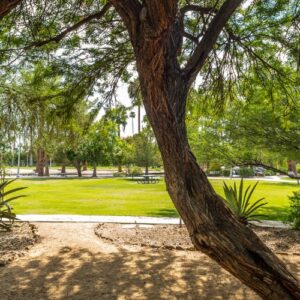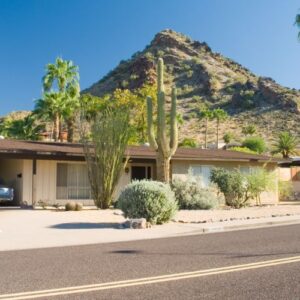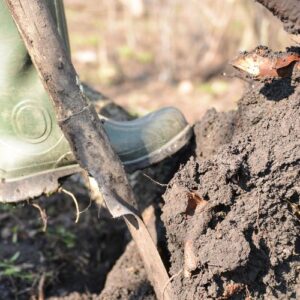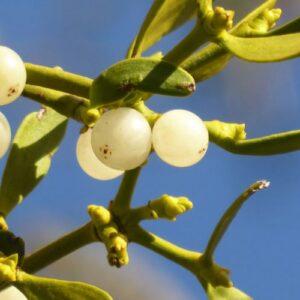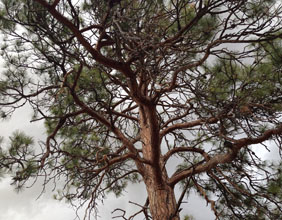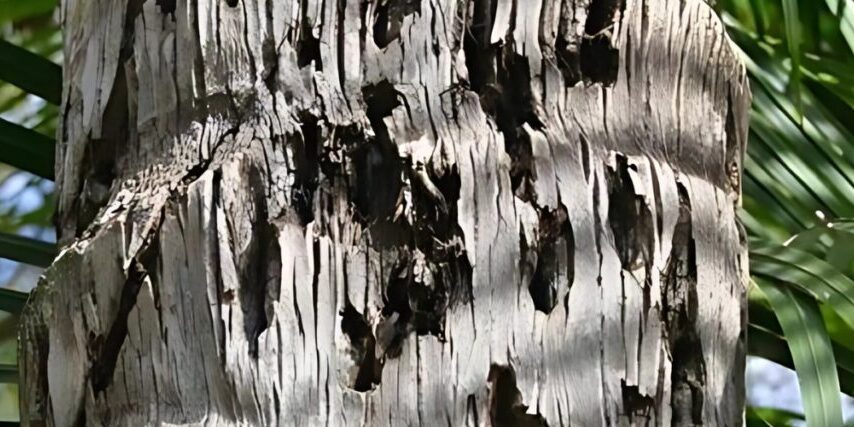
In North Phoenix neighborhoods like Paradise Valley, Scottsdale, and Cave Creek, mature trees aren’t just part of the scenery; they can add tens of thousands of dollars to your property’s value. Protecting that investment takes more than watering and fertilization. The techniques your tree care team uses can mean the difference between desert trees that thrive for decades and ones that decline prematurely, dragging down both their health and your home’s curb appeal.
Climbing spikes during tree pruning may seem harmless, but they leave deep, lasting wounds that make your trees vulnerable to pests, disease, and premature decline in our tough desert climate. The good news is that homeowners can completely avoid this risk by doing a little research and choosing reputable tree care companies that use safe, modern pruning practices – ensuring your trees remain strong, healthy, and valuable for years to come.
Key Takeaways
- Climbing spikes create permanent puncture wounds that serve as entry points for pests and diseases common to desert trees in the Phoenix area.
- Desert species, like mesquite and palo verde, have limited healing ability in our arid climate, making spike damage particularly devastating.
- Homeowners can easily identify spike damage by looking for small, evenly-spaced puncture wounds running up the trunk.
- To effectively access and work on tree canopies without damaging the trunk structure, professional arborists should use rope and harness systems.
- ISA-certified tree services follow industry standards that prohibit spike use except during tree removal operations.
What Are Climbing Spikes and Why Do Tree Companies Use Them?
Climbing spikes, also known as gaffs or spurs, consist of sharpened steel spikes attached to a climber’s boots or legs with leather straps and padded supports. These devices allow tree workers to scale tree trunks quickly by puncturing the bark and wood with each step upward.
Many tree service companies use climbing spikes because they offer speed and convenience. A worker can ascend a tree trunk in minutes using spikes, compared to the additional time required to set up ropes, harnesses, and other professional climbing equipment. For companies focused on completing as many jobs as possible in a day, spikes represent an attractive shortcut.
However, this convenience comes at a devastating cost to your trees’ health and longevity. In fact, industry leaders, like The International Society of Arboriculture (ISA) and the Tree Care Industry Association (TCIA), both oppose the use of climbing spikes during any tree work other than removal operations.
Expert Insight: “I’ve seen too many mature mesquite and palo verde trees slowly decline after spike damage – homeowners call us years later wondering why their once-thriving trees are suddenly struggling. The worst part is this damage was completely preventable. That’s why we’ve built our entire climbing program around spikeless techniques, even though it requires more training and investment in specialized equipment.” – Aaron Eubank, ISA Certified Arborist and Owner of Titan Tree Care
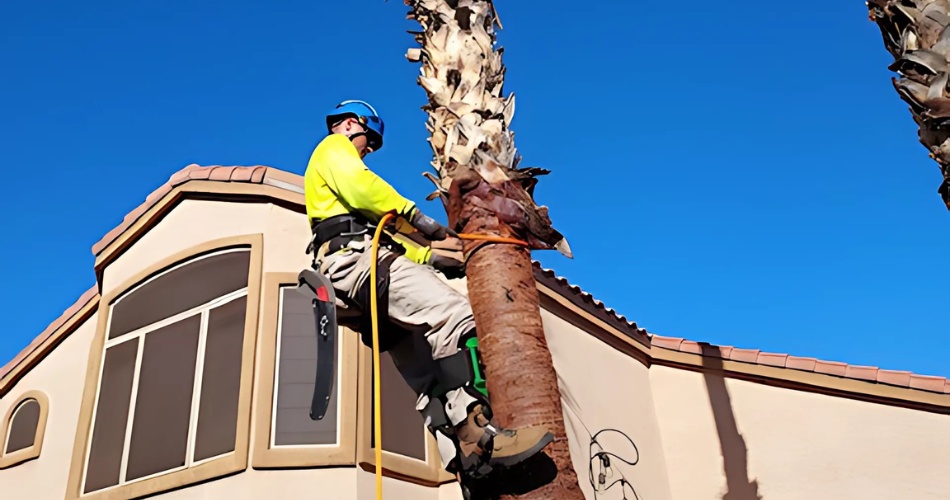
How Climbing Spikes Harm Your Trees
Every puncture from a climbing spike creates a wound that extends deep into the tree’s tissue. While these wounds may appear minor on the surface, they cause extensive damage to the tree’s vital systems and create long-lasting vulnerabilities.
Puncture Wounds Create Entry Points for Pests and Disease
Each spike wound provides a direct pathway for harmful organisms to penetrate the tree’s defenses. In the Phoenix area, trees already battle harsh conditions, and any wounds make them easy targets for desert pests and aggressive fungal diseases.
Common invaders that target wounded desert trees include:
- Palo verde borers that attack stressed palo verde and mesquite trees
- Flatheaded wood borers that target various desert species
- Fungal pathogens that thrive in Arizona’s monsoon humidity
- Bacterial infections that spread rapidly through compromised tissue
Damage to the Cambium Layer Disrupts Tree Health
Climbing spikes penetrate through the bark and into the cambium layer, the thin tissue responsible for transporting water and nutrients throughout the tree. This vital layer sits just beneath the bark and serves as the tree’s circulatory system.
When spikes puncture the cambium, it disrupts the flow of resources between the roots and canopy. Multiple spike wounds around the trunk can essentially “girdle” sections of the tree, cutting off nutrient transport and leading to dieback in affected branches or even entire sections of the canopy.
Why Desert Conditions Make Spike Damage Worse
The combination of extreme heat, limited water availability, and intense UV radiation in the Phoenix area creates a perfect storm for spike-damaged trees. Unlike trees in temperate climates that can dedicate significant resources to healing wounds, desert trees operate on much tighter energy budgets.
Desert healing challenges include:
- Slower Wound Closure: Dry air and intense heat mean healing takes years rather than months.
- Extended Vulnerability Periods: Because wounds remain open longer, pests and pathogens have prime access to the most vulnerable parts of the tree for extended periods.
- Limited Water for Recovery: Soil moisture constraints throughout the North Phoenix area reduce the tree’s ability to dedicate resources to wound healing.
Limited Resources Make Spike Damage Harder to Recover From
Phoenix-area trees must carefully balance their energy between survival functions like water conservation, heat tolerance, and wound healing. So, when a tree suffers extensive spike damage, it often cannot allocate sufficient resources to heal properly while maintaining its other vital functions.
This resource limitation means that spike-damaged trees in Paradise Valley, Desert Hills, Arcadia and communities across the greater Phoenix area may show symptoms of decline months or even years after the initial damage occurred.
Desert Trees Particularly Vulnerable to Spike Damage
North Phoenix’s most common tree species face unique challenges that make spike damage especially problematic. Desert-adapted trees have evolved to conserve resources and cope with extreme conditions, but this adaptation comes with limited healing capacity compared to trees in more temperate climates.
Common North Phoenix trees most at risk include:
- Mesquite (Prosopis species): Allocate energy toward drought survival over wound healing.
- Palo Verde (Parkinsonia florida): Struggle to compartmentalize wounds effectively.
- Desert Willow (Chilopsis linearis): Remain vulnerable for extended periods after damage.
When Spikes Should (and Shouldn’t) Be Used
Professional tree care specialists and Certified Arborists follow strict industry guidelines regarding spike usage. Understanding these standards helps North Phoenix homeowners make informed decisions about their tree care providers.
ISA Standards and Best Practices
The International Society of Arboriculture maintains clear standards for climbing spike usage. According to ISA guidelines, spikes should only be used on trees that are being removed entirely. Any tree intended to remain alive should be climbed using alternative methods that don’t damage the trunk.
Decades of arboricultural research and industry experience have made the risks of spike damage clear. That’s why the ANSI A300 Tree Care Standards, the industry’s benchmark for proper practices, explicitly prohibits the use of climbing spikes on live trees except in very limited circumstances.
Professional arborists invest in proper climbing equipment and training specifically to avoid causing unnecessary harm to the trees they’re hired to maintain.
The Only Time Spikes Are Acceptable
There are limited situations where climbing spikes are acceptable for use by professional tree services:
- Complete tree removal where the tree will be cut down entirely
- Emergency situations involving injured climbers or immediate safety threats
- Trees that are already dead and pose removal challenges
- Situations where no other climbing method is physically possible and the alternative is leaving a dangerous tree untreated
However, even in these exceptional cases, professional arborists first explore alternative climbing methods before resorting to spikes.
Alternative Climbing Methods
Modern arboriculture offers numerous techniques for safely accessing tree canopies without damaging the trunk:
- Rope and harness systems that anchor to strong branches rather than penetrating the trunk
- Aerial lifts and bucket trucks for trees with adequate access space
- Throwline techniques that allow climbers to set ropes high in the canopy
- Ladder systems for smaller trees or specific branch access
These methods require additional time, skill, and equipment investment, but they preserve tree health while allowing arborists to perform necessary maintenance work safely.
How to Identify if Your Trees Have Been Damaged by Climbing Spikes
North Phoenix homeowners can easily recognize spike damage by conducting a visual inspection of their trees. The signs are typically obvious once you know what to look for.
Visual indicators of spike damage include:
- Small, evenly-spaced puncture wounds running vertically up the trunk in parallel lines
- Sap oozing from multiple points on the trunk, indicating the tree’s trauma response
- Discolored or raised areas around old puncture sites where healing has been attempted
- Bark peeling or flaking around wound sites
- Linear patterns of damage that correspond to a climber’s upward progress
If you notice these signs on your mesquite, palo verde, or other desert trees, the damage may have compromised their long-term health and made them more susceptible to pest and disease problems.
Frequently Asked Questions About Using Climbing Spikes During Tree Pruning
Will using spikes void my tree’s warranty or insurance coverage?
Many tree warranties specifically exclude damage caused by improper care practices, including spike damage. Some homeowner’s insurance policies may also question coverage for tree-related property damage if the tree was maintained using practices that violate industry standards.
How much does spikeless tree climbing typically add to the cost of pruning?
Professional spikeless climbing is standard practice among Certified Arborists, so there’s typically no additional cost. Companies that use spikes are usually cutting corners to work faster, not to save you money. Quality tree care focuses on long-term tree health rather than short-term speed.
Can I legally require my tree service to avoid using spikes in their contract?
Absolutely. You can and should specify spikeless climbing techniques in your written contract. Reputable companies will have no problem with this requirement since it aligns with professional standards. This contractual language also protects you if damage occurs.
Are there certain times of year when spike damage is worse for desert trees?
Spike damage is harmful year-round, but wounds created during Phoenix’s intense summer heat may heal even more slowly. The combination of extreme temperatures and limited water availability puts additional stress on trees trying to recover from puncture wounds.
What should I do if a neighbor’s tree service used spikes on trees near my property line?
While you can’t control your neighbor’s tree care choices, you should document any visible damage with photos and consider having your trees inspected by a Certified Arborist if you’re concerned about potential pest or disease spread from compromised neighboring trees.
Do homeowner’s associations have any rules about tree care methods?
Some HOAs in North Phoenix communities are beginning to include language about professional tree care standards in their landscaping guidelines. Check your HOA covenants and consider advocating for standards that protect the community’s valuable tree canopy.

Protect Your North Phoenix Trees with Professional, Spikeless Tree Pruning
At Titan Tree Care, we never compromise your trees’ health for convenience. Our ISA-Certified Arborists use only professional rope and harness systems to access your tree canopies while pruning, ensuring your landscape investment remains healthy and beautiful for decades to come.
Call 623-444-8448 for your free consultation or request an estimate online.
More Articles Like This

Titan Tree Care is a full-service tree care company located in Anthem, AZ and serving all of North Phoenix. We offer a wide range of services to meet your tree care needs, including tree and palm trimming, tree pruning, tree removal, stump grinding, and more. We also offer insect or disease treatments and fertilization services. We are dedicated to providing high-quality, safe, and effective tree care services to our customers and work hard to ensure that your trees are healthy and look their best.





